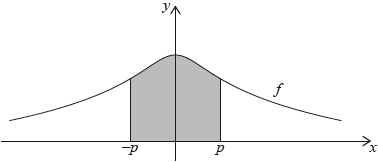DP Mathematics: Analysis and Approaches Questionbank

AHL 5.17—Areas under curve onto y-axis, volume of revolution (about x and y axes)
| Path: |
Description
[N/A]Directly related questions
-
20N.1.AHL.TZ0.H_12a:
State the equation of the vertical asymptote on the graph of .
-
20N.1.AHL.TZ0.H_12b:
State the equation of the horizontal asymptote on the graph of .
-
20N.1.AHL.TZ0.H_12c:
Use an algebraic method to determine whether is a self-inverse function.
-
20N.1.AHL.TZ0.H_12d:
Sketch the graph of , stating clearly the equations of any asymptotes and the coordinates of any points of intersections with the coordinate axes.
-
20N.1.AHL.TZ0.H_12e:
The region bounded by the -axis, the curve , and the lines and is rotated through about the -axis. Find the volume of the solid generated, giving your answer in the form , where .
-
20N.2.AHL.TZ0.H_3a:
Determine the values of , and .
-
20N.2.AHL.TZ0.H_3b:
Hence find the area of the shaded region.
-
20N.1.SL.TZ0.S_3a:
Find the value of .
-
20N.1.SL.TZ0.S_3b:
Find the volume of the solid formed when the shaded region is revolved about the -axis.
-
21M.2.AHL.TZ2.11c.i:
Find .
-
21M.2.AHL.TZ2.11a:
Show that the volume of the solid formed is cubic units.
-
21M.2.AHL.TZ2.11b:
Find the value of that satisfies the requirements of Pedro’s design.
-
21M.2.AHL.TZ2.11d.ii:
State the cross-sectional radius of the bowl at this point.
-
21M.2.AHL.TZ2.11c.ii:
Find .
-
21M.2.AHL.TZ2.11d.i:
By sketching the graph of a suitable derivative of , find where the cross-sectional radius of the bowl is decreasing most rapidly.
-
22M.2.AHL.TZ1.10c.i:
Show that the volume, , of water in the container when it is filled to a height of metres is given by .
-
22M.2.AHL.TZ1.10c.ii:
Hence, determine the maximum volume of the container.
-
22M.2.AHL.TZ2.6:
The following diagram shows the curve , where .
The curve from point to point is rotated about the -axis to form the interior surface of a bowl. The rectangle , of height , is rotated about the -axis to form a solid base.
The bowl is assumed to have negligible thickness.
Given that the interior volume of the bowl is to be , determine the height of the base.
-
19N.1.AHL.TZ0.H_10c:
Show that .
-
19N.1.AHL.TZ0.H_10d:
The area enclosed by the graph of and the line can be expressed as . Find the value of .
-
19N.2.AHL.TZ0.H_11b:
Find the area of .
-
19N.2.AHL.TZ0.H_11c:
The region is now rotated about the -axis, through radians, to form a solid.
By writing as , show that the volume of the solid formed is .
-
19N.2.SL.TZ0.S_8a:
Find the value of .
-
19N.2.SL.TZ0.S_8b.i:
Write down the coordinates of .
-
19N.2.SL.TZ0.S_8b.ii:
Find the equation of the tangent to the graph of at .
-
19N.2.SL.TZ0.S_8c.i:
Find the coordinates of .
-
19N.2.SL.TZ0.S_8c.ii:
Find the rate of change of at .
-
19N.2.SL.TZ0.S_8d:
Let be the region enclosed by the graph of , the -axis and the lines and . The region is rotated 360º about the -axis. Find the volume of the solid formed.
-
18N.2.SL.TZ0.S_10b.i:
Find the value of and of .
-
18N.2.SL.TZ0.S_10c:
When = 0, the volume of water in the container is 2.3 m3. It is known that the container is never completely full of water during the 4 hour period.
Find the minimum volume of empty space in the container during the 4 hour period.
-
17M.2.AHL.TZ2.H_2b:
Find the volume of the solid formed when the region bounded by the curve, the -axis for and the -axis for is rotated through about the -axis.
-
18N.2.SL.TZ0.S_10a:
Find the volume of the container.
-
18N.2.SL.TZ0.S_10b.ii:
During the interval < < , he volume of water in the container increases by m3. Find the value of .
-
16N.2.SL.TZ0.S_6a:
Use the model to find the volume of the barrel.
-
16N.2.SL.TZ0.S_6b:
The empty barrel is being filled with water. The volume of water in the barrel after minutes is given by . How long will it take for the barrel to be half-full?
-
17N.2.SL.TZ0.S_5b:
The following diagram shows part of the graph of .

The region enclosed by the graph of , the -axis and the lines and is rotated 360° about the -axis. Find the volume of the solid formed.
-
17N.2.SL.TZ0.S_5a:
Find the value of .
